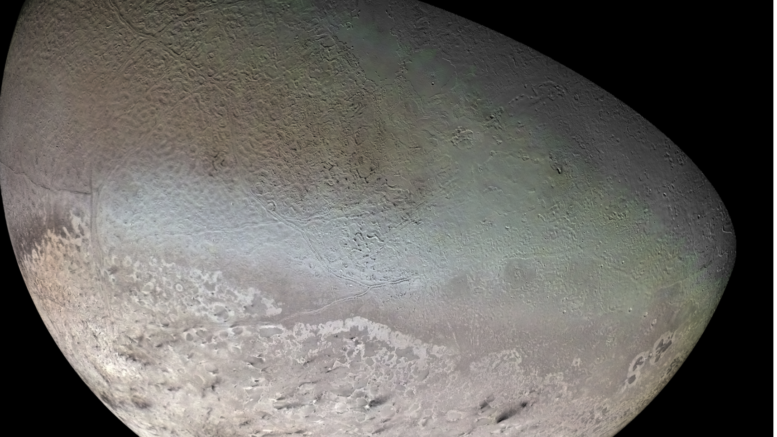Neptune has 14 known moons, which are named for minor water deities in Greek mythology. By far the largest of them is Triton, discovered by William Lassell on October 10, 1846, 17 days after the discovery of Neptune itself; over a century passed before the discovery of the second natural satellite, Nereid. Neptune’s outermost moon Neso, which has an orbital period of about 26 Julian years, orbits further from its planet than any other moon in the Solar System.[1]
A second moon of Neptune, named Nereid was discovered by Gerard P. Kuiper in 1949.[2] The third moon, later named Larissa, was first observed by Harold J. Reitsema, William B. Hubbard, Larry A. Lebofsky and David J. Tholen on May 24, 1981. The astronomers were observing a star’s close approach to Neptune, looking for rings similar to those discovered around Uranus four years earlier.[3] This is important because if rings were present around the planet, the luminosity would decrease slightly just before the planet’s closest approach. What they actually found was that the luminosity dipped only for several seconds, which meant that it was due to a moon rather than a ring.
No further moons were found until Voyager 2 flew by Neptune in 1989. Voyager 2 rediscovered Larissa and discovered five inner moons: Naiad, Thalassa, Despina, Galatea and Proteus.[4] In 2001 two surveys using large ground-based telescopes found five additional outer moons, bringing the total to thirteen.[5] Follow-up surveys by two teams in 2002 and 2003 respectively re-observed all five of these moons, which are Halimede, Sao, Psamathe, Laomedeia, and Neso.[5] A sixth candidate moon was also found in the 2002 survey and was lost thereafter: it may have been a centaur instead of a satellite, although its small amount of motion relative to Neptune over a month suggests that it was indeed a satellite.[5] It was estimated to have a diameter of 33 km and to have been about 25.1 million km (0.168 AU) from Neptune when it was found.[5]
Triton
Triton is the largest Neptunian moon, comprising more than 99.5% of the mass in orbit around Neptune, and it is the only one massive enough to be spheroidal. Triton was discovered by William Lassell just 17 days after the discovery of Neptune itself. Unlike all other large planetary moons in the Solar System, Triton has a retrograde orbit, indicating that it was captured rather than forming in place; it was probably once a dwarf planet in the Kuiper belt.[6] It is close enough to Neptune to be locked into a synchronous rotation, and it is slowly spiraling inward because of tidal acceleration. It will eventually be torn apart, in about 3.6 billion years, when it reaches the Roche limit.[7] In 1989, Triton was the coldest object that had yet been measured in the Solar System,[8] with estimated temperatures of 38 K (−235 °C).[9]
Scientists think Triton is a Kuiper Belt Object captured by Neptune’s gravity millions of years ago. It shares many similarities with Pluto, the best known world of the Kuiper Belt.But because of its unusual orbital inclination both polar regions take turns facing the Sun. Triton’s thin atmosphere is composed mainly of nitrogen with small amounts of methane. This atmosphere most likely originates from Triton’s volcanic activity, which is driven by seasonal heating by the Sun. Triton is one of the coolest objects in our solar system. It is so cold that most of Triton’s nitrogen is condensed as frost, giving its surface an icy sheen that reflects 70 percent of the sunlight that hits it. Spacecraft images show the moon has a sparsely cratered surface with smooth volcanic plains, mounds and round pits formed by icy lava flows. Triton consists of a crust of frozen nitrogen over an icy mantle believed to cover a core of rock and metal. Triton has a density about twice that of water.[10]
Further Readings
Check out the Planetary Bodies Category for previous and upcoming articles on the solar system planets.
Sources
[1] = http://ssd.jpl.nasa.gov/?sat_elem#neptune (as of Dec-2014)
[2] = Kuiper, Gerard P. (1949). “The Second Satellite of Neptune”. Publications of the Astronomical Society of the Pacific. 61 (361): 175–176. Bibcode:1949PASP…61..175K. doi:10.1086/126166
[3] = Reitsema, H. J.; Hubbard, W. B.; Lebofsky, L. A.; Tholen, D. J. (1982). “Occultation by a Possible Third Satellite of Neptune”. Science. 215 (4530): 289–291. Bibcode:1982Sci…215..289R. doi:10.1126/science.215.4530.289. PMID 17784355.
[4] = Smith, B. A.; Soderblom, L. A.; Banfield, D.; Barnet, C.; Basilevsky, A. T.; Beebe, R. F.; Bollinger, K.; Boyce, J. M.; Brahic, A. (1989). “Voyager 2 at Neptune: Imaging Science Results”. Science. 246 (4936): 1422–1449. Bibcode:1989Sci…246.1422S. doi:10.1126/science.246.4936.1422. PMID 17755997.
[5] = Holman, M. J.; Kavelaars, J. J.; Grav, T.; et al. (2004). “Discovery of five irregular moons of Neptune” (PDF). Nature. 430(7002): 865–867. Bibcode:2004Natur.430..865H. doi:10.1038/nature02832. PMID 15318214.
[6] = Agnor, Craig B.; Hamilton, Douglas P. (2006). “Neptune’s capture of its moon Triton in a binary–planet gravitational encounter”. Nature. 441(7090): 192–94. Bibcode:2006Natur.441..192A. doi:10.1038/nature04792. PMID 16688170.
[7] = Chyba, Christopher F.; Jankowski, D.G.; Nicholson, P.D. (1989). “Tidal evolution in the Neptune-Triton system”. Astronomy and Astrophysics. 219 (1–2): L23–L26. Bibcode:1989A&A…219L..23C.
[8] = Wilford, John N. (29 August 1989). “Triton May Be Coldest Spot in Solar System”. The New York Times. Archived from the original on 10 December 2008.
[9] = Nelson, R.M.; Smythe, W.D.; Wallis, B.D.; Horn, L.J.; et al. (1990). “Temperature and Thermal Emissivity of the Surface of Neptune’s Satellite Triton”. Science. 250 (4979): 429–31. Bibcode:1990Sci…250..429N. doi:10.1126/science.250.4979.429. PMID 17793020.
[10] = https://solarsystem.nasa.gov/moons/neptune-moons/triton/in-depth/

Be the first to comment on "Moons Of Neptune"